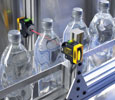
Banner WORLD-BEAM QS30 water sensors solve challenging liquid applications in clear, frosted or coloured containers.
Banner Engineering’s opposed mode water sensors provide an innovative solution for efficiently detecting water-based liquids in clear, frosted, coloured or even partially opaque bottles or containers. QS30 water sensors use a specially designed 1450 nm sensing beam, which is inherently absorbed by water, to make the previously challenging clear bottle/clear water combination detection a high-contrast application, enabling reliable detection. In addition, the sensors have high excess gain to burn through coloured glass, labelled or decorated bottles.

Principle of operation
The units consist of an emitter and a choice of either a low-power receiver, ideal for detecting water in clear bottles, or a high-power receiver, designed to effectively receive the emitted beam through partially opaque containers. In addition, the 13 mm diameter beam can be shaped using one of the three apertures that come standard with each emitter/receiver pair. The aperture reduces excess gain and narrows the sensing beam, facilitating accurate detection of water in vials, test tubes or other small vessels and containers.
“At a wavelength of 1450 nm, water absorbs about 1000 times more energy than at visible wavelengths, allowing the QS30 Water Sensor to deliver reliable results in two ways,” said Dennis Smith, technical marketing engineer at Banner. “When the bottle is clear, the energy absorption of the water creates high contrast between the water and the bottle. For example, a clear PET plastic bottle may attenuate about 5% of the light emitted, while the water attenuates about 95% of the light energy, allowing for simple discrimination between an empty or full bottle. The sensor also has the optical power to burn through many partially opaque glass and plastic containers, but not through the liquid contents,” Smith adds.
The QS30 Water Sensor is a member of Banner’s WORLD-BEAM QS30 product line, a family of easy-to-use sensing products with a wide array of sensing modes and sizes, and delivered in standard 30 mm housing. The sensor’s rich feature set also includes the following:
* Offers compact design and mounting versatility.
* Features rugged IP67 housing for harsh environments.
* Provides easy-to-read operating status indicators.
* Delivers excellent noise immunity and crosstalk avoidance.
* Resists environmental contamination from moisture and dirt.
* Includes bipolar NPN/PNP outputs, with a choice of light or dark operate models.
Applications
The unique design and robust ability of the QS30 Water Sensor make it an exceptional solution for demanding sensing applications, including:
* Fill level inspection in bottling applications.
* Test tube liquid detection.
* Food packaging inspection and verification.
For more information contact Rodney Topham, RET Automation, +27 (0)11 453 2468, [email protected], www.retautomation.com
| Tel: | +27 11 453 2468 |
| Email: | [email protected] |
| www: | www.turckbanner.co.za |
| Articles: | More information and articles about Turck Banner Southern Africa |

© Technews Publishing (Pty) Ltd | All Rights Reserved